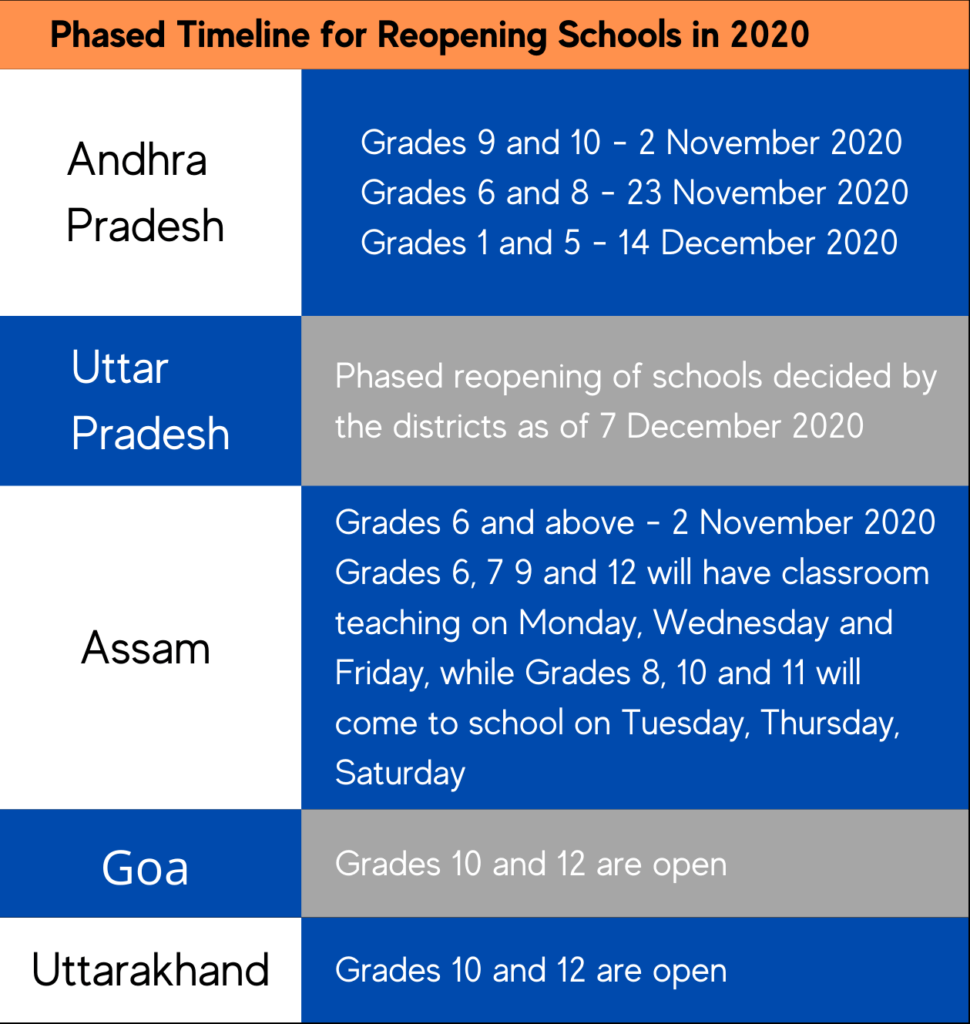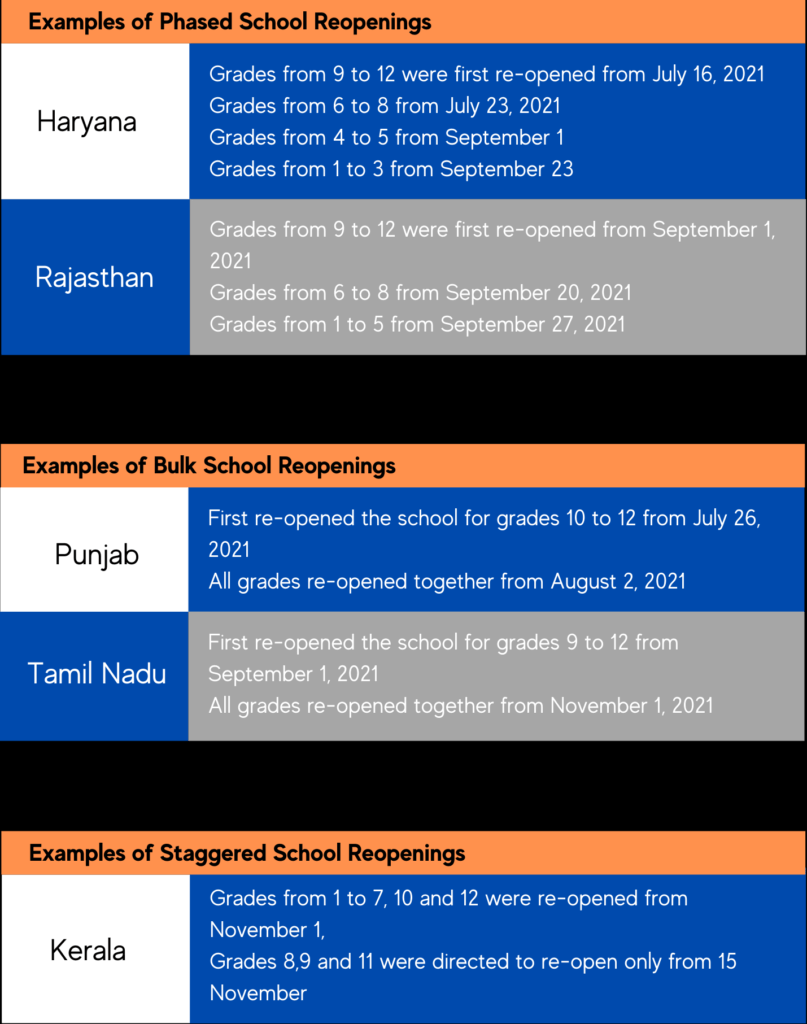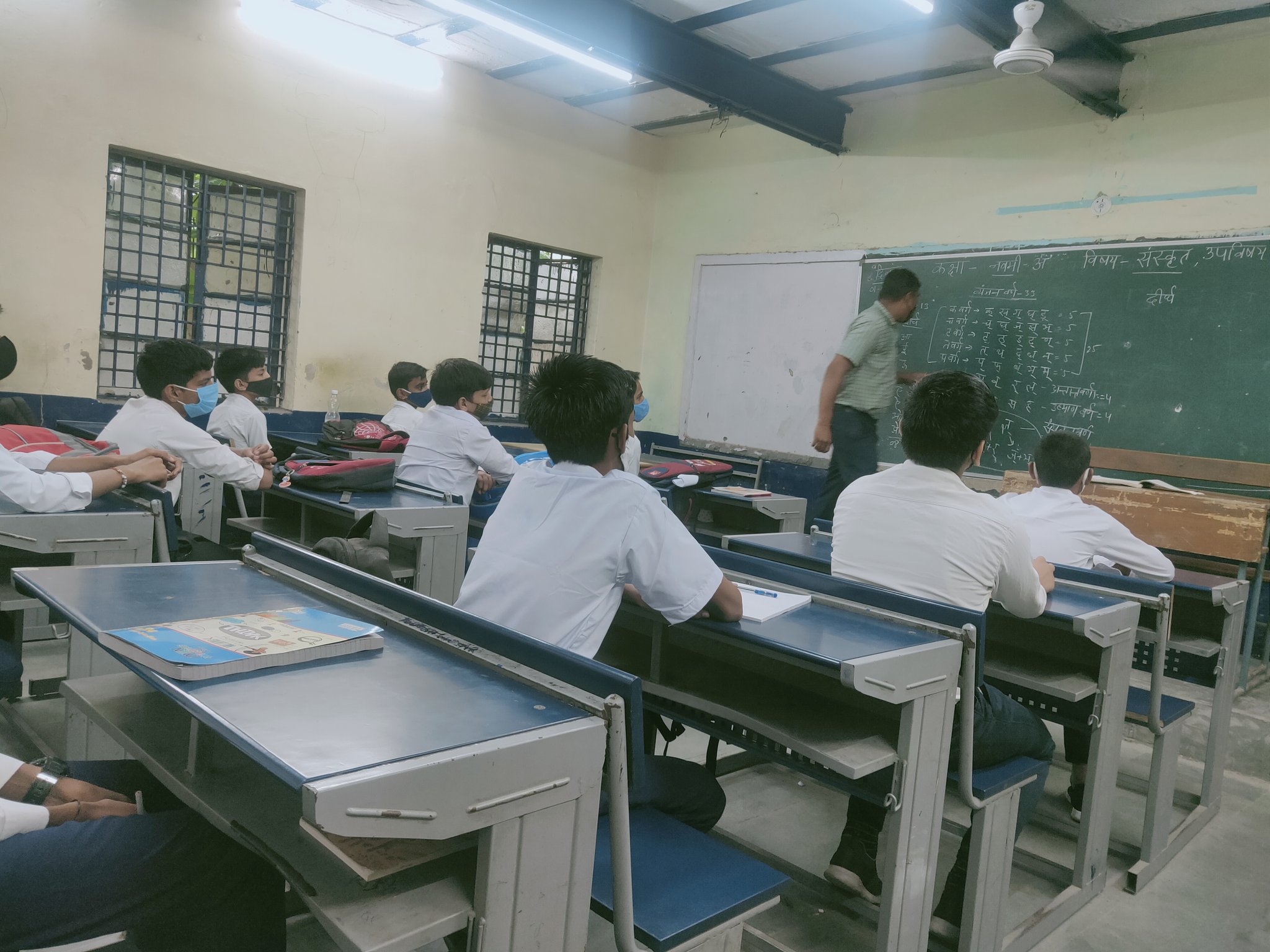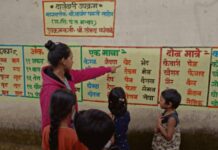Santosh, an auto-rickshaw driver in New Delhi, has enrolled his children in a government school. On a Friday evening a few weeks ago, he received a frantic call from his children. Schools are reopening from Monday, and they have to immediately arrange for school uniforms and stationery.
Santosh, a highly invested parent, makes a call to the school teacher to confirm the news and seek more details. The school teacher, on the other hand, received the information at the same time as Santosh did. He has no details to provide to Santosh, other than to ask him to wait for further instructions.
That evening, the school teacher received more than 60 such frantic calls from parents. He himself made 10 calls to seek official details on the reopening of schools.
⭄⭄⭄
Government schools in New Delhi were scheduled to be on Diwali break from 3 November to 7 November. The reopening of schools for all grades below Grade 9 had been on hold from 1 September.
Then came 29 October of this year, when the Delhi Disaster Management Authority issued a notice ordering the reopening of all schools in New Delhi from 1 November. In India, since March of 2020, around 320 million children have not stepped into a classroom for more than a year—which is a tenth of the entire duration of their schooling. This is one of the longest periods of school closures in the world.
Delhi family hired a band to celebrate the school reopening after 20 months pic.twitter.com/06EQ8ngD8t
— sudhir kumar (@sudhirkbokaro) November 14, 2021
Consequently, the Directorate of Education, New Delhi, issued guidelines on 29 October for school managements to safely see the reopening through. Similar guidelines were issued by local municipal corporations in New Delhi too.
Yet, the reality was that between 29 October and 1 November, parents, students, and school staff were given only two non-working days to prepare for reopening—creating some chaos regarding the implementation of the order. “Do we need to send the children from 1 November?,” Sushma, the mother of a student residing in West Delhi, asked me. “We do not have money to buy the school uniforms at such short notice. Is it fine if my children do not wear school uniforms? What are the school timings and what do my children need to bring to school?”
As seen in the case of Suresh, the school staff were themselves unsure of the path ahead—yet, they remained optimistic. “It is such happy news that we get to go back to physical classrooms,” said Aman, a teacher in a government school in South Delhi. “However, we have to act immediately and plan the next steps effectively to ensure an easy transition of students back to the classrooms.”
The questions now are: why reopen schools at all, and if we must, how smooth has this sudden transition from online to offline learning been?
⭄⭄⭄
In October of 2020, the Centre directed India’s state and union territory (UT) governments to decide on the reopening of schools and educational institutions. The order empowered them to prepare their own standard operating procedures regarding the health and safety of all students and teachers. Accordingly, a few states and UTs reopened schools—however, they were eventually closed with the devastating onset of the second wave of COVID-19 in India.

After the second wave, state governments and UTs have taken different stances on the manner of reopening schools. A number of states/UTs reopened schools in a phased manner across different grades, whereas others opened up all grades. A few opened in a staggered manner with no consistency across grades.

The Delhi Government reopened schools in bulk. Grades 9 to 12 resumed physical classes from September 1, 2021.
There were expectations that primary schools and Grades 6 to 8 would be reopened shortly thereafter. However, even after two months, no developments were made—resulting in parents and teachers staging protests outside Chief Minister Arvind Kejriwal’s residence demanding the reopening of school. “It has been close to a month since schools reopened, and there has been no COVID-19 case reported from any school. Even the positivity rate in the national capital is below 0.1 per cent,” said R.C. Jain, President of the Delhi State Public Schools Management Association, in conversation with PTI. “[So] We want schools to be reopened not only for Grades 6 to 8, but also for primary classes too. If there is a spike in cases, they can be closed again.”
The governments, parents, and teachers are insistent on schools reopening as the COVID-19 pandemic has presented unprecedented risks to children’s education, protection, and wellbeing.
These closures affect overall learning: a 2021 study by Azim Premji University across five states covering 16,067 children between Grades 2 to 6 indicates that 92% of children lost at least one specific language ability and 82% lost at least one specific mathematical ability from the previous year across all grades.
School closures also caused adverse effects on the physical and mental well-being of the children. According to UNICEF, over 33% of 5- to 13-year-olds and 50% of 14- to 18-year-olds reported poor or very poor mental health during India’s lockdowns.
This is not an anomaly—even evidence from prolonged school closures in the past shows that such disruptions can set generations of children back for life. For instance, Pakistan’s deadly 2005 earthquake led to 14 weeks of school closures on average—compared to their peers in other areas, affected children were behind in learning by 1.5 to 2 years.
It’s been 18 months since the COVID-19 outbreak started and education for millions of children is still disrupted. As of today, primary & secondary schools are shuttered in 19 countries, affecting over 156 million students. This should not go on.
Joint statement with @AAzoulay.
— Henrietta H. Fore (@unicefchief) July 12, 2021
⭄⭄⭄
The guidelines required government school authorities in New Delhi to do the following when reopening schools:
-
-
-
-
- Collect consent forms from parents to send their wards to school from 1 November.
- Prepare an isolation room in the school.
- Prepare to conduct daily thermal screening at school.
- Increase cleaning and sanitization facilities at the school premises.
- Ensure students do not share books, food or stationery.
- Divide the students into groups to ensure only 50% of the students are called in every day to attend school.
-
-
-
School staff had to also ensure that the consent form was shared with each of the students, that its contents were explained in detail, and then collect the signed slips before permitting students to attend classes.
Yet, parents were sceptical about the COVID-19 safety protocols in place in school. “We are not aware if the parents of other children and school staff are vaccinated,” said Dev Kishan, a parent of a student studying in a government school in South Delhi. “Without having access to such information, we are not comfortable sending our child to school.”
Parents first had to be counselled to provide consent forms—a time-consuming process in itself, requiring additional outreach from the school management. Only once these sessions ended, and upon the receipt of the consent forms, could the school management draw up timetables such that only 50% of students were physically present each day.
So, even though schools reopened on 1 November, teachers could not conduct physical classes, as they were primarily occupied with administrative tasks. Students and parents instead came to school every day seeking further details on the reopening, further crowding the premises. “We have visited the school thrice now, and still have not received any information on when physical classes will start for my children. They are not able to give us information on when food will be provided at school premises either,” said Madhur, a parent of a student studying in West Delhi.
Counselling aside, these parental fears may not be entirely unfounded: not all government schools have rooms available which can be easily converted into an isolation ward for potential COVID-19 positive students and staff. “We have only five rooms in our school premises, and if one room is used as an isolation room, we will have to club two grades in one classroom,” said Pushpa, a Headteacher at a government school in New Delhi. “We do not know how effective learning will happen in such circumstances, or whether we will be able to adhere to social distancing norms either.”
A number of schools in New Delhi are also being currently used as vaccination centres, COVID-19 testing centres, and ration distribution centres. The guidelines provide that such activities shall continue in demarcated areas—a directive that both school staff and parents have both raised concerns about.
“There are 200 vaccines for each site, so we have 750-800 people getting vaccinated in the school every day,” said a government school teacher in conversation with The Indian Express. “And there are other people at the school as well such as civil defence volunteers and guards. We don’t feel comfortable about exposing our girl students to all these strangers and don’t think it’s safe.”
Delhi: People form queues outside vaccination center at a government school in Badarpur. pic.twitter.com/IFwZ9u0jYA
— ANI (@ANI) May 7, 2021
To prevent the spread of COVID-19 at all, school managements have to procure equipment for thermal screening and masks. “The schools were provided with budgetary support for COVID-19 last year, but currently, no additional budget has been granted for procuring such equipment,” said Vikas, a Headteacher at a government school in New Delhi. “We do not have security guards at our school, so class teachers have to take turns standing at the gate: they have to check students’ temperatures and ensure no one enters the school premises without wearing a mask,” adds Nivedita, a teacher at a government school.
⭄⭄⭄
The guidelines also required teachers to start blended learning for students—which essentially means that teachers should teach using both offline and online modes of instruction.
To provide blended learning, it is imperative that the teachers are provided access to computers and the Internet. Yet, at the all India level, only 18% of rural schools have access to computers and 14% to the Internet; for urban schools, these figures are 43% and 42% respectively. For teachers specifically, only between 50% to 60% of government and private school teachers have access to laptops, while about 76% of government school teachers can access the Internet via their phones. These figures seem to ring true for the New Delhi experience: not all government teachers here have adequate digital infrastructure to facilitate blended learning.
“I take separate classes for students who come to school and for those who join virtually,” says Bhavana, a government school teacher. “I do not have a laptop to take virtual classes. We have received online training for conducting virtual classes but have not been trained to take physical and virtual classes together. I do not feel confident in my ability to teach using two modes in parallel.”
Additionally, teachers are not always compensated for their expenses.
“In the last 20 months, I have recharged data packs for at least 20 students every month to ensure they have access to online education,” recalls Satendra, a government school teacher in Delhi. “I have not been provided with any financial support from the school. I had to purchase a laptop for online classes which was not reimbursed by the school.”
⭄⭄⭄
The Delhi Government, via order dated November 13, 2021, once again closed all schools and educational institutions in the state for a week due to the severe rise in air pollution. What this means: schools were operational from November 1 to 2, closed for the Diwali break, reopened from November 8 to 13, and closed once again due to air pollution. They were only open for a total of nine working days, as noted by a group of 140 concerned parents in a letter to New Delhi’s Lieutenant Governor:
“Unfortunately, our children’s education was the first victim of the pollution response and school closures were announced on November 13 for one week. This has now been extended until further orders. While recognising the enormity of the pollution crisis and the risk it poses to our children’s health, we strongly urge the Delhi government to reconsider this decision and reopen schools.”
The transition to physical classrooms may have been smoother if the decision to reopen schools had been taken keeping in mind New Delhi’s annual smog season. There are also certain states that provided strategic preparation periods to school managements before restarting in-class instruction. In Kerala, the SOPs to reopen schools were issued in early October, however, the date of reopening was 1 November, giving authorities more than 15 days to prepare.
Even in New Delhi, to minimise crowding at the schools and ensure compliance with the DDMA guidelines, the East and North Delhi Municipal Corporations eventually decided to re-open the schools only from 8 November, after the Diwali break. The South Delhi Municipal Corporation too took matters into its own hands by hosting a ‘mega parent-teacher meeting’ to counsel parents before opening up campuses. Outlining a similar strategy at a larger scale from the get-go would have enabled all school managements and parents to prepare better from 1 November.
In any case, as of 29 November, New Delhi’s schools and educational institutions are once again open for classes. As we move ahead, school managements need to be provided with financial and technical assistance in order to adhere to the reopening guidelines and to provide a safe environment for the students and teachers. It is also imperative to provide assistance to school teachers to help them provide blended learning. In addition to offering training in this learning style, financial support, adequate digital infrastructure, and recruiting IT personnel in each government school who can offer digital assistance to teachers may also help smoothen the transition. The government has implemented some effective plans to curb the adverse impact of the pandemic. With a second chance at reopening schools not to mention the discovery of a new variant of the COVID-19 virus, we need to leverage these learnings to avoid the consequences that a lack of strategic planning can have on a child’s education.
*All names in this piece have been anonymised. | Featured image: students attend physical classes this year at a government school in Ghittorni, New Delhi; courtesy of Shraddha Chettri via Twitter.






